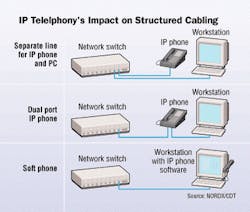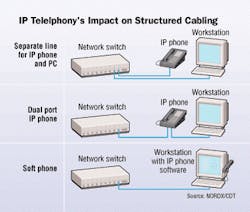The buzzword phrase in today's network cabling industry is "IP telephony." Many see this technology as a major evolutionary step in telecommunications. It uses Internet Protocol (IP) to transport voice signals over a data network. Instead of using the conventional analog (sine-wave) voice signal, the protocol converts human speech into a digital signal (1s and 0s), just like the data packets that travel through the network.
Evolutionary? Yes. But IP telephony is more revolutionary than evolutionary because it merges two very different and critical worlds: voice telephony, which is highly cost-sensitive and requires rock-solid reliability; and data networks, which accept occasional failures, are subject to rapid change, and need a lot of bandwidth.
A solution that merges these two worlds must simultaneously offer reliability, cost-effectiveness, a high data rate, and the ability to evolve quickly. That's a significant challenge for IP telephony solution providers, who must develop and market a solution that takes into account these seemingly incompatible needs.
The pros and cons of IP telephony versus "classic" telephony have been debated in many papers and will not be rehashed here. We want to focus on the impact that IP telephony will have on the design and deployment of LAN structured cabling.
IP telephony devices
Once you make the choice to use IP telephony, you must choose the interface between the voice packet and the user. Two options are available for the job: an IP phone, which looks like a traditional phone but acts more like a PC; or a PC with IP telephony software and microphone/speaker or USB handset—also known as a "soft phone."
All major IP telephony companies market IP phones. With list prices ranging from $300 to more than $1,000, they are substantially more expensive than regular phone sets. Advanced models, however, allow access to more advanced services, including Web surfing and Internet banking. They can also be used as "port extensions" to connect a computer directly to the phone.
If IP phones make the data world look like a voice world, the "soft phone" (a PC with IP telephony software) plunges the user into the data world, with voice communication done directly through the computer. Since most of today's computers have integrated speakers and microphones, the only significant incremental cost is the license for IP telephony software. You can also purchase an IP telephone set that looks like a standard phone set, but links directly to the computer's USB port.
IP telephony architecture
Now that we have described the devices used to interface with IP networks, let's look at the three architecture choices:
- Two separate lines—one for the IP phone and one for the PC.
- A dual-port IP phone on a single line. The input port connects the IP phone to the IP network, and the output port connects the computer to the IP phone.
- A soft phone on a single line. Software uses the multimedia capabilities of the PC's sound card and microphone/headset.
Each architecture will have its own impact on the structured cabling topology.
Using the first architecture—separate lines for the IP phone and the PC—represents the classic approach. It lets the two devices be linked to two different switch ports. This option has significant advantages:
- Troubleshooting is easier because the two devices are physically independent;
- Quality of service can be improved by assigning prioritization by switch port;
- Capability is optimized because each device independently negotiates its required data rate with the network;
- Remote powering of the IP phone can be assigned by using a powered IP switch or a midspan power unit.
The other telephony architectures—installing a dual-port IP phone or a soft phone, using a "one-line-for-everything" option—are initially attractive because just one data cable is required per workstation. Some IP telephony vendors have trumpeted this advantage to help boost penetration of dual-port IP phones, arguing that the user can offset the higher incremental equipment cost with reduced cabling costs.
As attractive as the one-line-for-everything option sounds at first, users should carefully plan the structured cabling topology when deploying this architecture. Having a single cable carry all information reduces flexibility and redundancy. Any problem, or the need for additional services like broadband video or 1000Base-T applications, will require pulling new cables, thereby disrupting service and incurring additional cost.
According to the TIA/EIA-568-B.1 cabling standard, published in May 2001, each workstation requires two horizontal cables—one with a minimum of Category 3 performance (Category 5e recommended) for traditional voice services, and one with a minimum of Category 5e performance for data applications.
Since IP telephony is now being added to the data network, both horizontal cables at the workstation should be considered as cables to support data applications. Thus, a minimum of Category 5e performance is required to support both the data line and the IP telephony line.
As of June 2002, however, a new cabling-system standard has entered the scene—the TIA/EIA-568-B.2-1, "Transmission Performance Specifications for 4-pair 100-W Category 6 Cabling." Cabling systems that meet the Category 6 specifications offer greater performance and higher bandwidth than Category 5e systems. Category 6 offers 200 MHz of useable bandwidth, versus 100 MHz for Category 5e.
One of the most significant advantages of a Category 6 cabling system is the improved signal-to-noise ratio (SNR). At the receiver end of a cabling circuit, you expect the signal to be stronger than the noise so the digital signal (all the 1s and 0s) can be detected. Using today's levels of bandwidth, Category 6 cabling has a much better SNR—about 16 times better than Category 5e—which will become increasingly important as new applications come online. Another benefit for today's applications is that Category 6 has been shown to provide higher data throughput (fewer bit errors) than Category 5e for applications such as 100- and 1,000-Mbit/sec Ethernet.
When it comes to cabling design, considering future technologies is mandatory. It is expected that Category 6 will soon supersede Category 5e due to the introduction of new technologies and the ever-increasing need for bandwidth.
Power over UTP and cable design
A critical need for any phone system is its ability to function at any time, especially during a power outage. In traditional phone systems, uninterrupted power is provided to the phone set by either the central office or the PBX system. This architecture, used with low power consumption devices (less than 10 W per phone set) connected to a centralized power source (a UPS), lets traditional phone systems remain operational during power outages.
The introduction of IP telephony greatly changed the parameters of the sensitive power supply equation. Power-hungry devices, such as switches and IP phone sets that require uninterrupted power, are now widely dispersed. Switches located in telecommunications rooms are easily linked to UPS systems; supplying power to IP phone sets is a more-challenging task.
The IEEE has mandated Group 802.3af (Data Terminal Equipment [DTE] Power via Media Dependent Interface) to define the power sources to be used with Ethernet standard-based products. This standard lets data terminal equipment, such as IP phones, draw power from the same generic cabling as that used for data transmission.
Adding DC power to the data signal is a convenient and efficient way to use one medium (the structured cabling system) to fulfill power and data needs. Integrating these needs on the same cabling system will most likely lead to more stringent requirements for the structured cabling network's performance. Defining these requirements is a critical objective of the IEEE 802.3af Group.
Power source equipment (PSE) may deliver power over the two unused pairs in 10Base-T or 100Base-TX (pairs 4-5 and 7-8). Alternatively, the standard allows for delivering power over the signal pairs (pairs 1-2 and 3-6) directly through switch ports. Whichever option is used, the PSE will deliver power only over the same pairs as those used for detection. The maximum PSE power output level is 15.4 W at 44 to 56 V.
Three practical power options are available:
- Voice over IP switches with integrated power supplies. Installed in the telecommunications room, these switches can be used to provide power to IP phones via the cabling system.
- Midspan units. These devices are installed between the active switch and the patch panels to add a DC signal to the data signal, letting the existing network power-up the IP phones. The advantage of midspan units is that they offer power to IP phone units using legacy switches.
- Standalone power sources, consisting of a simple power source plugged into a regular electrical outlet. This is the least-expensive option, but in the event of a power outage, the IP phone will not function.
null
IP telephony's impact on the way we design and implement our structured cabling systems will be substantial, and it will come quickly. Several changes should be expected:
- The consolidation of voice and data cabling needs. Today, the TIA requires two horizontal cabling drops per work-area location; the first is for voice applications (Category 3 minimum required, Category 5e recommended), the second is for data applications (Category 5e minimum required). The introduction of IP telephony requires that both horizontal cables at the workstation be data-capable. Thus, a Category 5e performance requirement is the minimum expectation for both cabling drops. Category 6 cable is recommended for improved performance and future readiness.
- The need for improved signal-to-noise ratio. Since the majority of today's networks are Category 5e or lower, IP telephony manufacturers have designed solutions that can run on Category 5e cabling. But once the convergence of voice, data, and video is complete, the need for much-improved SNR and greater bandwidth will justify Category 6 structured cabling systems.
- The need for power-over-UTP. Today's phones are fully functional during power outages, but emergency power units are not available for most of the data network equipment. Once the two applications are running on the same network, powering some or all network equipment will be required. IP telephony-ready structured cabling systems, therefore, will need a plan for powering active devices during a power outage. Power-over-UTP will be a critical technology for achieving this goal.
- The mission-critical data network. The last major effect the introduction of IP telephony will have on the data network will be to make it mission-critical; therefore, its performance must be carefully controlled. Structured cabling systems that guarantee system performance will become ever more important to end users.
IP telephony is an emerging technology, and its needs are rapidly evolving before us. Today's structured cabling must take into account both present and future needs if it is to become an asset—not a limitation—to the deployment of IP telephony.
Andre Mouton is product line manager, and Julie Roy is manager of IBDN systems and standards at NORDX/CDT (www.nordx.com).

